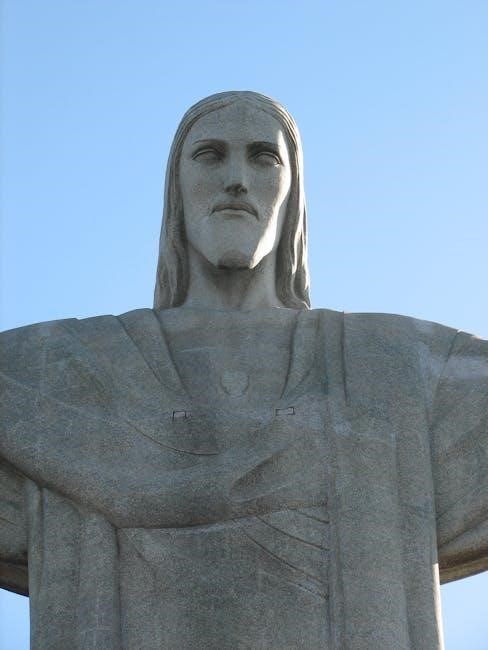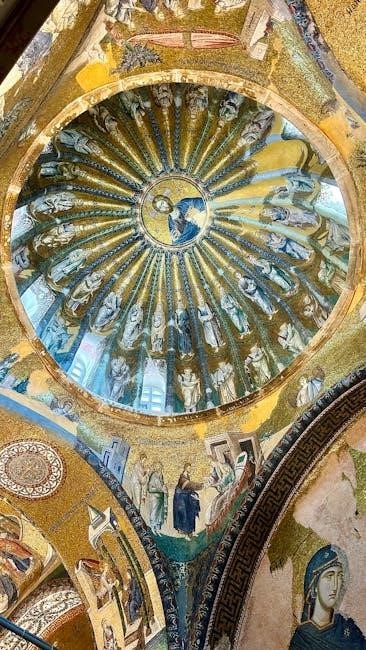Jesus is the unified message of the Bible, revealed through types, prophecies, and titles from Genesis to Revelation. He is the Seed of Woman, Passover Lamb, High Priest, and ultimate Victor.
The Unity of Scripture Revealing Jesus
The Bible, written by over 40 authors across 1,500 years, presents a unified message about Jesus Christ. From Genesis to Revelation, Jesus is the central theme, revealed through types, prophecies, and titles. The Old Testament lays the foundation, with promises of a Messiah who would redeem humanity, while the New Testament fulfills these promises in Jesus. The unity of Scripture is evident in how Jesus is portrayed as the solution to humanity’s sin problem, beginning with the Seed of Woman in Genesis and culminating in Him as the Alpha and Omega in Revelation. This cohesive narrative demonstrates God’s eternal plan of salvation, with Jesus at its core. The Bible’s unity underscores the divine authorship and purpose, showing how every book, from Genesis to Revelation, points to Jesus as the ultimate revelation of God.
The Central Theme of Jesus in the Bible
Jesus is the central theme of the Bible, woven throughout its 66 books. From Genesis to Revelation, He is portrayed as the solution to humanity’s sin problem. In Genesis, He is the Seed of Woman, while in Exodus, He is the Passover Lamb. Leviticus depicts Him as the High Priest, and Numbers as the Cloud and Pillar of Fire. Deuteronomy presents Him as the City of Refuge, symbolizing safety and redemption. This pattern continues through the Old Testament, with Jesus as the Scarlet Thread in Joshua, the Judge in Judges, and the Kinsman Redeemer in Ruth. The New Testament fulfills these types, revealing Jesus as the Messiah and Savior in the Gospels and as the ascended Lord and returning King in Acts to Revelation. His presence in every book underscores His role as the ultimate revelation of God, making Him the unifying thread of Scripture.

Jesus in the Old Testament
Jesus is present throughout the Old Testament, symbolized as the Seed of Woman in Genesis, the Passover Lamb in Exodus, the High Priest in Leviticus, and the Cloud and Pillar of Fire in Numbers, while Deuteronomy portrays Him as the City of Refuge, collectively illustrating His role as humanity’s redemption.
Genesis: Jesus as the Seed of Woman
In Genesis, Jesus is prophetically revealed as the Seed of Woman, a pivotal image symbolizing His redemptive mission. This imagery, rooted in Genesis 3:15, foretells the ultimate victory of Jesus over Satan, depicting the spiritual conflict between good and evil. The Seed represents the Messiah who would crush the serpent, embodying God’s promise of salvation. This prophecy lays the groundwork for the biblical narrative, highlighting Jesus as the solution to humanity’s sin. The Seed of Woman symbolizes His divine origin and humanity’s hope for redemption. This imagery is fulfilled in the New Testament, where Jesus defeats sin and death, aligning with the broader biblical theme of salvation. Through this typology, Genesis establishes Jesus as the central figure of redemption, setting the stage for His role as the Passover Lamb and High Priest in subsequent books.

Exodus: Jesus as the Passover Lamb
In Exodus, Jesus is symbolized as the Passover Lamb, a profound representation of His redemptive role. The Passover narrative in Exodus 12 details how the lamb’s blood spared the Israelites from death, foreshadowing Jesus’ sacrifice. The lamb had to be without blemish, symbolizing Jesus’ sinless nature. The blood applied to the doorposts mirrored the salvific power of Jesus’ blood, which saves believers from spiritual death. This typology highlights Jesus as the ultimate Passover Lamb, who offers redemption through His death. The New Testament reaffirms this connection, as John the Baptist declares, “Behold, the Lamb of God who takes away the sin of the world” (John 1:29). The Exodus account establishes Jesus as the fulfillment of God’s plan to deliver His people, transitioning from the Old Testament shadow to the New Testament reality. Through this imagery, Exodus powerfully illustrates Jesus’ role as the Savior who provides salvation through His sacrifice.
Leviticus: Jesus as the High Priest
Leviticus portrays Jesus as the ultimate High Priest, fulfilling the sacrificial and intercessory roles of the Levitical priesthood. The book emphasizes the need for atonement through sacrifices, symbolizing Jesus’ role as the perfect offering. In Leviticus, the high priest mediated between God and humanity, offering sacrifices for sin and maintaining covenant relationship. Similarly, Jesus serves as humanity’s eternal High Priest, interceding on behalf of believers (Hebrews 4:14-16). Unlike the Levitical priests, Jesus’ priesthood is eternal (Psalm 110:4), and His sacrifice is once-for-all, accomplishing complete atonement. The detailed rituals in Leviticus foreshadow Jesus’ role as both the sacrifice and the priest, offering Himself to reconcile humanity with God. This connection underscores the continuity of God’s redemptive plan, with Jesus fulfilling the symbolic practices of the Old Testament as the true and perfect High Priest.
Numbers: Jesus as the Cloud and Pillar of Fire
In the book of Numbers, Jesus is symbolized by the cloud and the pillar of fire that guided the Israelites through the wilderness. This divine presence represented God’s leadership and protection, prefiguring Jesus’ role as the ultimate Guide and Protector of His people. The cloud and fire symbolize God’s constant presence with His people, just as Jesus is ever-present with believers today. The pillar of fire, which provided light in the darkness, parallels Jesus’ role as the “Light of the World” (John 8:12), illuminating the path for those who follow Him. Similarly, the cloud that shaded the Israelites by day reflects Jesus’ provision and care, shielding believers from spiritual and physical harm. This imagery in Numbers underscores Jesus’ role as the divine Leader who guides, protects, and sustains His people throughout their journey, fulfilling the symbolic presence of the cloud and fire in the Old Testament.
Deuteronomy: Jesus as the City of Refuge
In Deuteronomy, Jesus is typified as the City of Refuge, a place of safety and asylum for those who sought refuge from punishment. The Cities of Refuge, established by God’s command, provided protection for the unintended actions of individuals, symbolizing Jesus’ role as the ultimate refuge for sinners. Just as the Cities of Refuge were accessible and clearly marked, Jesus offers salvation to all who come to Him, providing eternal security from the consequences of sin. This imagery highlights Jesus’ role as the only true haven where believers can find forgiveness and deliverance. The Cities of Refuge also foreshadow the spiritual safety and rest that Jesus offers to those who trust in Him, fulfilling the promise of a divine sanctuary for humanity.

Jesus in the New Testament
Jesus is revealed as the Messiah and Savior, with His life, teachings, death, and resurrection forming the core of Christianity. He is also depicted as the Ascended Lord and divine ruler of the church.
Matthew to John: Jesus as the Messiah and Savior
The Gospels of Matthew, Mark, Luke, and John present Jesus as the long-awaited Messiah, fulfilling Old Testament prophecies. He is depicted as the Son of God, who came to save humanity from sin. Jesus’ teachings, miracles, and sacrificial death on the cross are central to the narrative. His resurrection demonstrates His power over sin and death. The Gospels emphasize His divine mission to bring salvation and establish the Kingdom of God. Through His life and ministry, Jesus revealed God’s love and provided redemption for all people. His teachings on love, forgiveness, and eternal life continue to guide followers. The Gospels conclude with the promise of eternal life through faith in Jesus, making Him the ultimate Savior and Redeemer.
Acts to Revelation: Jesus as the Ascended Lord and Returning King
Following His resurrection, Jesus ascended to heaven, as recorded in Acts, where He is seated at the right hand of God, interceding for believers. The Epistles reveal Him as the exalted Lord, the head of the church, and the source of spiritual life. Jesus is portrayed as the mediator between God and humanity, the righteousness of believers, and the one who meets their every need. In Revelation, Jesus is unveiled as the Returning King, who will judge the nations and establish His eternal kingdom. He is described as the Alpha and Omega, the beginning and the end, emphasizing His eternal sovereignty. The book of Revelation concludes with Jesus as the Final Victor, defeating evil and uniting with His bride, the church, in the New Jerusalem. This section of Scripture underscores Jesus’ ultimate triumph and His promise to return, inspiring hope and anticipation among believers.

Jesus in Revelation
Jesus is revealed as the Alpha and Omega, the ultimate Victor over evil, and the Bridegroom uniting with His church in the New Jerusalem, fulfilling God’s eternal plan.
Revelation 1: Jesus as the Alpha and Omega
In Revelation 1, Jesus is unveiled as the Alpha and Omega, the eternal beginning and end of all things. This title emphasizes His divine sovereignty and unchanging nature. John’s vision portrays Jesus standing among seven lampstands, symbolizing His presence in and over the churches. His description as “the Word of God” (Revelation 1:16) underscores His role as the source of divine truth and judgment. The sharp, double-edged sword proceeding from His mouth signifies the power of His words to discern and judge the hearts of believers. Jesus’ role as the Alpha and Omega highlights His authority over history, creation, and redemption. This imagery reaffirms His promise to return and fulfill God’s ultimate plan. Revelation 1 presents Jesus as both the humble suffering Savior and the glorious, exalted Lord, bridging the gap between His first and second comings. His title as the Alpha and Omega reminds believers of His eternal presence and faithfulness.
Revelation 20-22: Jesus as the Final Victor and Bridegroom
In Revelation 20-22, Jesus is revealed as the Final Victor and Bridegroom, completing God’s redemptive plan. He destroys Satan forever (Revelation 20:10) and judges the wicked, ensuring justice and righteousness reign. The final judgment separates the righteous from the wicked, with believers rewarded for their faithfulness. Jesus then prepares the New Jerusalem, symbolizing His eternal union with His bride, the church. The imagery of the Lamb’s wedding feast underscores His role as the divine Bridegroom, promising eternal fellowship with His people. Revelation 22 emphasizes Jesus’ imminent return, encouraging believers to remain faithful and longing for His second coming. The book concludes with Jesus’ promise to bring all things to completion, establishing an eternal kingdom where God dwells with humanity. This final vision of Jesus as Victor and Bridegroom inspires hope and worship, highlighting His ultimate triumph and eternal love for His people.



0 Comments